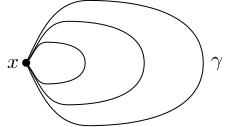If big F from G to H is a homomorphism of Lie groups then there exists a linear map F star from little g to little h which is a Lie algebra homomorphism (i.e. F star of X bracket Y equals F star of X bracket F star of Y) such that F of exp X equals exp of F star X for all X in little g.
Lie's theorem on homomorphisms
Exponentiating homomorphisms
Last time we proved the following theorem.
What about the other direction? If we're given a Lie algebra homomorphism little f from little g to little h, can we find a Lie group homomorphism big F from G to H such that F star equals little f?
Take G = H = U(1). Then little g equals little h equals the imaginary numbers so, for any smooth homomorphism F from U(1) to U(1) we get star from i R to i R. Since F star is linear and i R is 1-dimensional, F star of i theta equals i lambda theta for some lambda in R.
The Lie bracket on i R is trivial: i theta_1 bracket i theta_2 equals i squared theta_1 theta_2 minus i squared theta_2 theta_1, equals 0, so F star automatically preserves the bracket. Therefore any lambda defines for us a Lie algebra homomorphism i R to i R, i theta maps to i lambda theta.
So any homomorphism F from U(1) to U(1) has the form F of e to the i theta equals e to the i lambda theta for some lambda. Which lambda can occur? Not all of them. For F to be well-defined, we need F of e to the 2 pi i equals F of 1 (because e to the 2 pi i equals 1) so we need e to the 2 pi i lambda equals 1 and hence we need lambda to be an integer. Conversely, if lambda is an integer then F of e to the i theta equals e to the i lambda theta is well-defined: it's just raising e to the i theta to the (integer) power lambda.
So not every Lie algebra homomorphism can be exponentiated to get a Lie group homomorphism: i theta maps to i lambda theta can be exponentiated if and only if lambda is an integer.
This example is sufficiently important to summarise as a lemma:
The maps F_n of e to the i theta equals e to the i n theta, n in Z, are homomorphisms U(1) to U(1) and every smooth homomorphism U(1) to U(1) is one of these.
The integers come into this example because the group U(1) has some interesting topology. U(1) is a circle, so loops in U(1) have a winding number that counts how many times they go around the circle. The Z in the lemma is related to this integer winding number.
Simply-connectedness
There is a topological condition you can put on G to ensure that any Lie algebra homomorphism exponentiates.
Let G be a simply-connected matrix group and H any matrix group. Then for every Lie algebra homomorphism little f from little g to little h there exists a smooth group homomorphism big F from G to H such that F star equals f.
We will not prove this theorem: it's a gorgeous proof and would make an excellent project!
A space X is called
A loop in X is a continuous map gamma from the interval 0,1 to X such that gamma of 0 equals gamma of 1. You should think of gamma of t as a parametrised path with parameter t in the interval 0,1, which starts and ends at the same point. If X is a matrix group then continuity here means that the matrix entries of gamma of t depend continuously on t.
A nullhomotopy of a loop gamma is a continuous map H from the square 0,1 times 0,1 to X (which we can think of as a family of loops gamma_s of t equals H of s,t) such that:
-
these loops all start and end at the same point x (so H of s,0 equals H of s,1 equals x for all s in the interval 0,1.
-
gamma_0 of t equals H of 0,t is our loop gamma of t
-
gamma_1 of t equals H of 1,t is the constant loop H of 1,t equals x.
In other words, gamma_s of t starts being gamma and gradually shrinks down to a constant loop.

The circle is certainly not simply-connected, but there are plenty of groups which are simply-connected. There is an optional video which talks more about the topology of the groups we've been meeting which will give a vague explanation for why the groups SU(n) are simply-connected. I also have some videos about topology, simply-connectedness and the fundamental group if you want to learn more about this (you could do a project about the topology of Lie groups).